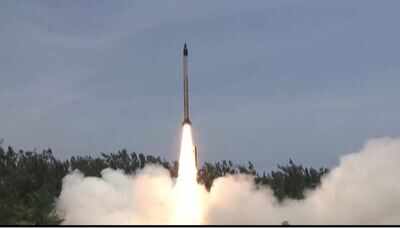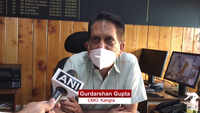
NEW DELHI: India on Monday successfully tested an indigenously-developed hypersonic technology demonstrator vehicle (HSTDV), powered by a scramjet engine, which will serve as the building block for next-generation hypersonic cruise missiles.
Congratulating DRDO scientists for the “landmark achievement”, defence minister Rajnath Singh said that with the successful HSTDV flight test, using the indigenously developed scramjet propulsion system, all critical technologies have now been established to progress to the next phase.
The test of the HSTDV, designed to cruise at Mach 6 speed with the scramjet engine, was conducted from the Dr Abdul Kalam Island off the Odisha coast at 11.03 am. “It met all the laid down technical parameters,” said a scientist.
The HSTDV project is basically aimed at demonstrating autonomous flight of a scramjet integrated vehicle, which can have multiple civilian applications, including launching satellites at a low-cost, as well as military uses in the shape of long-range cruise missiles.
The DRDO said the mission demonstrated capabilities for the highly-complex technology that will serve as the building block for next-generation hypersonic vehicles in partnership with the Indian industry.
DRDO chairman Dr G Satheesh Reddy congratulated all the scientists, researchers and other personnel related with the HSTDV mission for "their resolute and unwavering efforts towards strengthening the nation’s defence capabilities".
Only a handful of countries, like the US, Russia and China, have demonstrated this capability till now. A scramjet engine is an improvement over the ramjet engine because the former operates efficiently at hypersonic speeds and allows supersonic combustion. Ramjets, in contrast, operate well at supersonic speeds around Mach 3 but their efficiency drops at hypersonic speeds.
The maiden launch of the HSTDV, powered by the solid rocket motor of an Agni ballistic missile, in June last year had failed. The HSTDV was supposed to “fire and fly on its own” after being carried to an altitude of around 30 km but the Agni booster could not achieve the desired altitude.
Congratulating DRDO scientists for the “landmark achievement”, defence minister Rajnath Singh said that with the successful HSTDV flight test, using the indigenously developed scramjet propulsion system, all critical technologies have now been established to progress to the next phase.
The @DRDO_India has today successfully flight tested the Hypersonic Technology Demontrator Vehicle using the indige… https://t.co/AYayZ0zees
— Rajnath Singh (@rajnathsingh) 1599459912000I congratulate to DRDO on this landmark achievement towards realising PM’s vision of Atmanirbhar Bharat. I spoke to… https://t.co/PJraOpYbhZ
— Rajnath Singh (@rajnathsingh) 1599459913000The test of the HSTDV, designed to cruise at Mach 6 speed with the scramjet engine, was conducted from the Dr Abdul Kalam Island off the Odisha coast at 11.03 am. “It met all the laid down technical parameters,” said a scientist.
The HSTDV project is basically aimed at demonstrating autonomous flight of a scramjet integrated vehicle, which can have multiple civilian applications, including launching satellites at a low-cost, as well as military uses in the shape of long-range cruise missiles.
The DRDO said the mission demonstrated capabilities for the highly-complex technology that will serve as the building block for next-generation hypersonic vehicles in partnership with the Indian industry.
Chairman DRDO congratulated all the Scientists, Researchers and other personnel related with #HSTDV mission for the… https://t.co/2F6i3531Yo
— DRDO (@DRDO_India) 1599461896000DRDO chairman Dr G Satheesh Reddy congratulated all the scientists, researchers and other personnel related with the HSTDV mission for "their resolute and unwavering efforts towards strengthening the nation’s defence capabilities".
Only a handful of countries, like the US, Russia and China, have demonstrated this capability till now. A scramjet engine is an improvement over the ramjet engine because the former operates efficiently at hypersonic speeds and allows supersonic combustion. Ramjets, in contrast, operate well at supersonic speeds around Mach 3 but their efficiency drops at hypersonic speeds.
The maiden launch of the HSTDV, powered by the solid rocket motor of an Agni ballistic missile, in June last year had failed. The HSTDV was supposed to “fire and fly on its own” after being carried to an altitude of around 30 km but the Agni booster could not achieve the desired altitude.
Download
The Times of India News App for Latest India News

Coronavirus outbreak
Trending Topics
LATEST VIDEOS
India
 55 healthcare workers contracted COVID-19 in Kangra: CMO Gurdarshan Gupta
55 healthcare workers contracted COVID-19 in Kangra: CMO Gurdarshan Gupta  Jharkhand couple who drove to Gwalior to write exam, get air ticket for return journey
Jharkhand couple who drove to Gwalior to write exam, get air ticket for return journey  India is emerging as big manufacturing centre: Ravi Shankar Prasad
India is emerging as big manufacturing centre: Ravi Shankar Prasad  Passenger trains start from Indore after 168 days
Passenger trains start from Indore after 168 days  National Education Policy focuses on learning and studying: PM Modi
National Education Policy focuses on learning and studying: PM Modi  Covid-19: India records 13% jump in caseload last week
Covid-19: India records 13% jump in caseload last week
More from TOI
Navbharat Times
Featured Today in Travel
Quick Links
Coronavirus in MumbaiCoronavirus in KolkataCoronavirus in HyderabadCoronavirus in DelhiCoronavirus in BangaloreCoronavirus symptomsCoronavirus in IndiaWhat is CoronavirusCoronavirus NewsSolar EclipseNPRWhat is NRCCAB BillCAB and NRCRTI BillPodcast newsLok SabhaShiv SenaYSRCPCongressBJP newsUIDAIIndian ArmyISRO newsSupreme Court
Get the app



